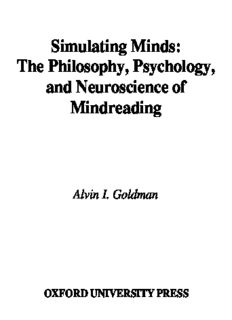
Simulating Minds: The Philosophy, Psychology, and Neuroscience of Mindreading PDF
Preview Simulating Minds: The Philosophy, Psychology, and Neuroscience of Mindreading
Simulating Minds: The Philosophy, Psychology, and Neuroscience of Mindreading Alvin I. Goldman OXFORD UNIVERSITY PRESS Simulating Minds PHILOSOPHY OF MIND SeriesEditor DavidJ.Chalmers,AustralianNationalUniversity SelfExpressions Minds,Morals,andtheMeaningofLife OwenFlanagan TheConsciousMind InSearchofaFundamentalTheory DavidJ.Chalmers DeconstructingtheMind StephenP.Stich TheHumanAnimal PersonalIdentitywithoutPsychology EricOlson MindsandBodies PhilosophersandTheirIdeas ColinMcGinn What’sWithin? NativismReconsidered FionaCowie PurpleHaze ThePuzzleofConsciousness JosephLevine ConsciousnessandCognition AUnifiedAccount MichaelThau ThinkingwithoutWords Jose´LuisBermu´dez IdentifyingtheMind SelectedPapersofU.T.Place EditedbyGeorgeGrahamand ElizabethR.Valentine APlaceforConsciousness ProbingtheDeepStructureoftheNaturalWorld GreggRosenberg ThreeFacesofDesire TimothySchroder GutReactions APerceptualTheoryofEmotion JesseJ.Prinze IgnoranceandImagination OntheEpistemicOriginoftheProblemofConsciousness DanielStoljar SimulatingMinds ThePhilosophy,Psychology,andNeuroscienceofMindreading AlvinI.Goldman Simulating Minds The Philosophy, Psychology, and Neuroscience of Mindreading Alvin I. Goldman 1 2006 1 OxfordUniversityPress,Inc.,publishesworksthatfurther OxfordUniversity’sobjectiveofexcellence inresearch,scholarship,andeducation. Oxford NewYork Auckland CapeTown DaresSalaam HongKong Karachi KualaLumpur Madrid Melbourne MexicoCity Nairobi NewDelhi Shanghai Taipei Toronto Withofficesin Argentina Austria Brazil Chile CzechRepublic France Greece Guatemala Hungary Italy Japan Poland Portugal Singapore SouthKorea Switzerland Thailand Turkey Ukraine Vietnam Copyright(cid:1)2006byOxfordUniversityPress,Inc. PublishedbyOxfordUniversityPress,Inc. 198MadisonAvenue,NewYork,NewYork10016 www.oup.com OxfordisaregisteredtrademarkofOxfordUniversityPress. Allrightsreserved.Nopartofthispublicationmaybereproduced, storedinaretrievalsystem,ortransmitted,inanyformorbyanymeans, electronic,mechanical,photocopying,recording,orotherwise, withoutpriorpermissionofOxfordUniversityPress. LibraryofCongressCataloging-in-PublicationData Goldman,AlvinI.,1938– Simulatingminds:thephilosophy,psychology,andneuroscienceofmindreading/ AlvinI.Goldman. p.cm.—(Philosophyofmindseries) Includesbibliographicalreferencesandindex. ISBN-13978-0-19-513892-4 ISBN0-19-513892-9 1. Socialperception. 2. Empathy. I. Title. II. Series. BF323.S63G652006 128'.2—dc22 2006040043 9 8 7 6 5 4 3 2 1 PrintedintheUnitedStatesofAmerica onacid-freepaper For Fiona This page intentionally left blank Preface A perennial problem in philosophy of mind is how we understand self and others,howweidentifythefeelings,thoughts,anddesignsthatcomposeour owndailylivesandthoseofourneighbors,lovers,andfoes.Isthereanything tobelearnedherefromcommonlore?Peopleoftensaythattheyunderstand others by empathizing with them, by putting themselves in others’ shoes: ‘‘I feel your pain.’’ Is there any truth to this expression? Contemporary neu- rosciencehasdeterminedthatthereismuchtruthtoit.Whenpeopleobserve othersinpain,part(thoughnotall)oftheirownpainsystemisactivated.This provides an initial piece of scientific support for the intuitive idea that un- derstandingothersismediatedbyputtingourselvesintheir(mental)shoes.In itsbareessentials,thisiswhatthesimulationtheoryholds.Simulationtheory is one approach to how people ‘‘mindread,’’ the general question we’ll be tackling here froman interdisciplinary perspective. I began publishing on mental simulation in the late 1980s (Goldman, 1989),inthewakeofpapersbyRobertGordon(1986)andJaneHeal(1986). Functionalistand‘‘theory-theory’’approachestofolkpsychology,or‘‘theory ofmind,’’wereascendant atthetime,inbothphilosophyanddevelopmental psychology. The trio of papers by Gordon, Heal, and me created a critical massthatputsimulationtheoryonthemapasaninterestingalternative.The tworivalswerejuxtaposedina1992doubleissueofMindandLanguage,in which philosophers Stephen Stich and Shaun Nichols and developmental psychologists Josef Perner, Alison Gopnik, and Henry Wellman sang the praises of theory-theory, while Gordon, I, and developmentalist Paul Harris defendedsimulationtheory.Thedebatehascontinuedeversince.Intheearly 1990s, I published several other papers on simulation theory, including ones related to ethics (Goldman, 1992, 1993c) and the foundations of economic viii Preface theory(Goldman,1995).Anotherpaper(Goldman,1993a)addressedtheself- attributionofmentalstates,adistinctbutcriticalpartofthefullmindreading story. A new angle emerged in 1998, when I heard Vittorio Gallese talk about mirrorneuronsataconferenceinTucson.Nooneattheconferencehadheard of mirror neurons, but to my ears they struck a simulationist chord. The Italian neuroscientists who discovered mirror neurons, including Gallese, wereunfamiliarwiththegeneralissueofmindreadingandsimulationtheory inparticular.Iproposedaconnectionbetweenthem:Mirrorneuronsmightbe a mechanism of primitive mindreading of a simulationist variety. We pub- lishedthisideainTrendsinCognitiveSciences(GalleseandGoldman,1998), creating a new link between cognitive neuroscience and the theory of mind- reading. The approach obviously needed refinement, however, to deal more carefully and systematically with philosophical issues, developmental find- ings, and other approaches in cognitive neuroscience. So, after finishing a book on another topic (social epistemology), I turned to the present project, which has absorbed my attention for more than five years. There are many debts to acknowledge on this project, for early influences and collaborations, as well as comments on the manuscript. First, there is Robert Gordon, who kept the torch of simulationism burning through the 1990s. Second, Steve Stich and Shaun Nichols laid down significant chal- lenges to simulation theory that forced simulationists to address tough ques- tions yet also created excellent openings for our responses. Next, and of major importance, is Vittorio Gallese. During and after our collaboration in 1998, he kept me regularly updated on emerging work from the Parma la- boratory,explainedtechnicaldetails,andpinpointedkeyissuesonthemirror- neuron front. (This is by no means the only front of interest here, however.) Although we sometimes disagree on philosophical details, Vittorio’s friend- shipandbreadthofvisionhavebeencrucial.GiacomoRizzolatti,theheadof the Parma laboratory, led the way with ingenious experiments and insights thatyieldedrevolutionaryfindings.HehasgraciouslywelcomedmetoParma and invited my participation in a major cognitive neuroscience institute. Thanks for recent collaboration go to Chandra Sripada, who brought great energy and a neuroscience background to our collaboration on emotion mindreading, which occupies a core part of chapter 6. In terms of manuscript commentary, my greatest debt is to Kelby Mason, whoservedasresearchassistantontheprojectfortwoyears.Hefocusedhis microscope on all aspects of the manuscript (through multiple drafts) and provided incisive comments both philosophical and psychological. A few of his points are recorded in footnotes, but in many more instances his com- ments saved me from errors or ambiguities and yielded improvements in clarity, organization, and presentation. I gratefully received briefer stints of research assistance from Karen Shanton, Kevan Edwards and Fre´de´rique de Preface ix Vignemont.Amongthemanuscriptreadersforthepress,PhilipRobbinsgave me unusually detailed and helpful comments. David Chalmers, as series editor, raised a number of insightful and important points, resulting in sig- nificant revisions. Many other commentators provided valuable pointers, for which I am grateful. They include Ralph Adolphs, Paul Bloom, Roberto Casati, Greg Currie, Jean Decety, Ori Friedman, Josh Greene, Andrea Heberlein, Pierre Jacob, Marc Jeannerod, Andrew Lawrence, Alan Leslie, Brian Loar, George Loewenstein,CynthiaMacDonald,AndyMeltzoff,JasonMitchell,IrisOved, Elisabeth Pacherie, Gualtiero Piccinini, Joelle Proust, Eric Schwitzgebel, Natalie Sebanz, Holly Smith, and Leaf van Boven. I am also indebted to several graduate seminars, one at the University of Arizona and two at Rutgers, where early or late versions of manuscript material were critically discussed. I am happy to acknowledge financial support from the National Endow- ment for the Humanities, which awarded me a fellowship for university teachers during the academic year 2000–2001. The project was then entitled ‘‘MindUnderstanding Mind.’’Myresearchwasalsosupportedbyaresearch professorship from the Social and Behavioral Science Research Institute of the University of Arizona (2000). Portions of the book draw on material from previous or concurrent pub- lications, specifically Goldman and Sripada, ‘‘Simulationist Models of Face- Based Emotion Recognition,’’ Cognition (2005); Sripada and Goldman, ‘‘SimulationandtheEvolutionofMindreading,’’inA.Zilhao,ed.,Evolution, Rationality, and Cognition, Routledge (2005); Goldman, ‘‘Conceptual Clar- ification and Empirical Defense of the Simulation Theory of Mindreading,’’ in C. Kanzian, J. Quitterer, and E. Runggaldier, eds., Persons: An Inter- disciplinary Approach, Obvahaupt (2003); Goldman, ‘‘Imitation, Mind Reading, andSimulation,’’inS. Hurleyand N.Chater,eds., Perspectiveson Imitation, vol. 2, MIT Press (2005); and Goldman, ‘‘Imagination and Simu- lation inAudience Response toFiction’’in S. Nichols,ed., The Architecture of the Imagination (2006).
Description: